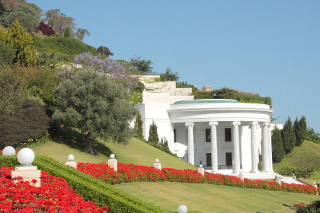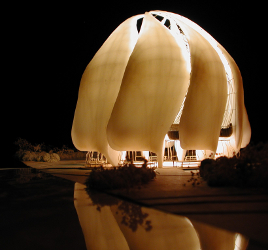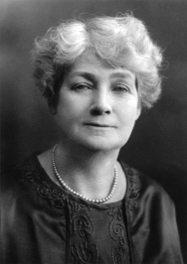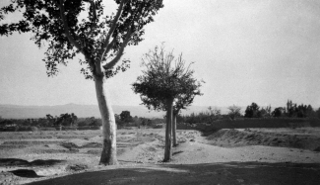The Jewish high priest who presided at the court which tried and condemned Jesus.
A-Z : Caiaphas
The two sons of Adam and Eve.
A-Z : Cain and Abel
Calendar, Bahá’í
See Bahá’í Calendar
Literally, “successors” or “vicegerents”. The Shí‘íhs hold that the successors of the Prophet must be the members of His own family, but they do not use the title Khalífih or “Caliph.” The sulṭán of Turkey assumed this title early in the 16th century.
A-Z : Caliphate
An inn for caravans.
Carmel, Mount
See Mount Carmel
Carmel, Tablet of
See Tablet of Carmel
Cause of God, Hands of
A collective reference to Bahá’u’lláh, the Founder of the Bahá’í Faith; the Báb, Forerunner of Bahá’u’lláh and Founder of the Bábí Faith; and ‘Abdu’l-Bahá, authorized Interpreter of the Bahá’í Writings.

Image copyright ©
Romane Takkenberg, 2009
Home to the Research Department, whose roles includes providing assistance to the Universal House of Justice “in consulting the Sacred Writings”, and in the preparation of “translations and commentaries on the authoritive texts of the Faith”. (A Wider Horizon: Selected Messages of the Universal House of Justice 1983–1992, page 52.)
Centre of Sedition
A title of ‘Abdu’l-Bahá, referring to His appointment by Bahá’u’lláh as the successor to whom all must turn after Bahá’u’lláh’s passing.
See also : Book of the Covenant; Covenant.
A-Z : ‘Abdu’l-Bahá ~ Center of Covenant
Certitude, Book of
See The Kitáb-i-Íqán
Chaste One
See Fáṭimih
In the Bible the Cherubim appear as distinct from the angels who are Jehovah’s messengers, while the Cherubim are found where God is personally present: e.g. “And he [God] rode upon a cherub.” (Psalms 18: 10).
Figures of Cherubim were wrought into the hangings of the Holy of Holies and were represented above the Mercy Seat within. In later tradition, the Cherubim were included among the nine orders of angels.
See also : Gabriel.
A-Z : Cherubim
Chief Stewards
Chief Temple Builder
Mother Temple of South America
Night view, model
Image copyright ©
Bahá’í International
Community
Architect: Siamak Hariri
Located nearby to Santiago, construction began November 2010 with commencement of the excavations. The doors were opened on October 19th 2016. (Bahá’í Temple of South America (https://bahai.cl/templobahai/))
See : Mashriqu’l-Adhkár.
Greek title for Jesus. Greek for anointed
A-Z : Jesus Christ
Cities, Twin Holy
See Twin Holy Cities
1869 — November 1960

Image copyright ©
Bahá’í International
Community
Known to many as “Mother Dunn”. Wife of Hyde Dunn.
Clara and Mr Dunn left their home in America to settle in Australia in response to the following passage from Tablets of the Divine Plan from ‘Abdu’l-Bahá:
“O that I could travel, even though on foot and in the utmost poverty, to those regions, and raising the call of ‘Yá Bahá’u’l-Abhá’ in cities, villages, mountains, deserts and oceans, promote the Divine teachings! This, alas, I cannot do. How intensely I deplore it! Please God, ye may achieve it.”
Mr. Dunn resigned his position, and he and Clara left their home in San Francisco for Australia, where they remained for the rest of their lives, working to establish the Faith in Australia and New Zealand. They were the first Bahá’ís to set foot in Australia, on 18 April 1920. She was 55 at the time.
For a brief account of her life and service to the Faith, see The Bahá’í World 13:859-62.
That which veils one from the recognition of God's Manifestation.
On page 66 of the Kitáb-i-Íqán Bahá’u’lláh summarises the term “clouds” as: “... those things that are contrary to the ways and desires of men.” He then, on page 67 describes just a few of these “clouds”:
“... the annulment of laws, the abrogation of former Dispensations, the repeal of rituals and customs current amongst men, the exalting of the illiterate faithful above the learned opposers of the Faith. ... the appearance of that immortal Beauty in the image of mortal man, with such human limitations as eating and drinking, poverty and riches, glory and abasement, sleeping and waking, and such other things as cast doubt in the minds of men ...”
He states on this same page"
“Even as the clouds prevent the eyes of men from beholding the sun, so do these things hinder the souls of men from recognizing the light of the divine Luminary.”
Form taken by the first books that replaced scrolls. It is made of a sheets of paper, vellum, papyrus, or similar, the contents being hand-written. Some are folded concertina-like.
Hereditary Israelite/Jewish Temple-Priest; Hebrew for Priest
Collins, Amelia
See Amelia Collins
Commentary on the Súrih of Joseph
See Qayyúmu’l-Asmá’
Committee, European Teaching
Committee, Inter-America
Committees, Regional
The Bahá’í community.
See also : Greatest Name.
Also known by the names People of the Well, or the People of Ar-Rass.
An ancient community, mentioned in the Qur’án as a people who strayed from the Path of God and were thus subsequently destroyed. Little otherwise is known of them
See also Wikipedia https://en.wikipedia.org/wiki/Companions_of_the_Rass
The consultative meetings of the entire body of the Hands of the Cause of God.
Following Shoghi Effendi’s death in 1957, the meetings were held over a period of several days each autumn from 1957 through 1962, when the Hands were responsible for maintaining the unity of the Bahá’í community and for completing the goals of the Ten Year World Crusade.
Conclaves continued to be held for a number of years after the election of the Universal House of Justice and were the occasion of consultations between the House of Justice and the body of the Hands on many matters of great significance for the Bahá’í Faith.
The company of holy souls of the spiritual world.
‘Abdu’l-Bahá also comments that “... the concourse on high are souls who are firm in the Covenant.”
A-Z : Concourse ~ on high

Image copyright ©
Bahá’í International
Community
Held over a three week period over June—July 1848, and attended by Bahá’u’lláh, Quddús and Ṭáhirih, plus approximately 80 other male Bábís.
See Nabíl’s The Dawn-Breakers, chapter XVI, page 288 for details.
See also : Badasht Academy.
Now known as Istanbul
Capital city of the Byzantine Christian Empire and Orthodox Church until ad 1453, renamed Istanbul by the Ottomans.
Described by Bahá’u’lláh in the Kitáb-i-Aqdas as “the throne of tyranny” because of the cruelty and injustice of Sulṭán ‘Abdu’l-‘Azíz.
A-Z : Constantinople; Tablet(s) ~ of Bahá’u’lláh
A document adopted by the Universal House of Justice on 26 November 1972.
The Constitution of the Universal House of Justice consists of two parts: the Declaration of Trust, which sets forth the origins and duties of the Universal House of Justice, and the By-Laws, which specify the terms under which the Universal House of Justice operates and define its relationship to other institutions of the Bahá’í Administrative Order.
In Bahá’í usage, a technical term referring to the process of collective decision-making.
The aim of Bahá’í consultation is to arrive at the best solution or to uncover the truth of a matter. Among the requisites for consultation that are set out in the Bahá’í Writings are love, harmony, purity of motive, humility, lowliness, patience, and long-suffering. Individuals not only have the right to express their views, but they are expected to express them fully and with the utmost devotion, courtesy, dignity, care, and moderation.
If unanimity is not achieved, decisions are arrived at by majority vote. Once a decision is reached, all parties, having had the opportunity to express their views fully, are to work together wholeheartedly to implement it. If the decision is wrong, ‘Abdu’l-Bahá says, through unity the truth will become evident and “the wrong made right”.
A-Z : Consultation
Compilation : Consultation: A Compilation
An institution of the Bahá’í Administrative Order established by the Universal House of Justice in 1968 to extend into the future the functions of protection and propagation of the Faith assigned to the Hands of the Cause of God by ‘Abdu’l-Bahá in His Will and Testament. Its members are appointed to five-year terms by the Universal House of Justice and serve in five zones — Africa, the Americas, Asia, Australasia, and Europe.
The International Teaching Centre co-ordinates the work of the Continental Boards of Counsellors, who are assisted in their work by Auxiliary Board members, whom they appoint and supervise.
Continental Fund
See Fund
Responsible for gathering and supplying information for and about pioneers and international travelling teachers. Their work complements the functions of the Continental Boards of Counsellors and National Spiritual Assemblies.
There are five such committees: one each for Africa, the Americas, Asia, Australasia, and Europe. Members are appointed by the Universal House of Justicee; their work is directed by the International Teaching Centre.
Convention, International Bahá’í
Convention, National
The Copts were descendants of the ancient Egyptian stock. They were unbelievers in the time of Moses.
See also : Sept.
A-Z : Copt
Generally, an agreement or contract between two or more people, usually formal, solemn, and binding.
The Universal House of Justice explains, in a letter dated 23 March 1975, that a religious covenant is “a binding agreement between God and man, whereby God requires of man certain behaviour in return for which He guarantees certain blessings, or whereby He gives man certain bounties in return for which He takes from those who accept them an undertaking to behave in a certain way.”
The Universal House of Justice also explains that there are two types of religious covenant: “There is … the Greater Covenant which every Manifestation of God makes with His followers, promising that in the fullness of time a new Manifestation will be sent, and taking from them the undertaking to accept Him when this occurs. There is also the Lesser Covenant that a Manifestation of God makes with His followers that they will accept His appointed successor after Him. If they do so, the Faith can remain united and pure. If not, the Faith becomes divided and its force spent.”
In the Bahá’í Dispensation the Greater Covenant refers to the renewal of God’s ancient Covenant through the appearance of the twin Manifestations of God, the Báb and Bahá’u’lláh, and the promise of another Manifestation to come in the future after the passage of at least one thousand years. The Lesser Covenant, in this case, refers to Bahá’u’lláh’s Covenant with His followers, which establishes ‘Abdu’l-Bahá as the Centre of the Covenant. It confers upon ‘Abdu’l-Bahá the authority to interpret Bahá’u’lláh’s Writings in order “to perpetuate the influence” of the Faith and to “insure its integrity, safeguard it from schism, and stimulate its world-wide expansion.” The Lesser Covenant also establishes the Guardianship and the Universal House of Justice as the twin successors of Bahá’u’lláh and ‘Abdu’l-Bahá.
See also : Covenant-Breaker.
A-Z : Covenant(s)
Compilation : The Covenant
Covenant, Book of the
A Bahá’í who attempts to disrupt the unity of the Faith by defying and opposing the authority of Bahá’u’lláh as the Manifestation of God for this Age, or His appointed successor, ‘Abdu’l-Bahá, or after Him, the Guardian and the Universal House of Justice.
Bahá’ís who continue, despite remonstrances, to violate the Covenant are expelled from the Faith by the Universal House of Justice. This provision preserves the unity of the Faith, which is essential to achieving its cardinal purpose of uniting humankind. It also preserves the purity of Bahá’u’lláh’s teachings from the disruptive influence of egoistic individuals who, in past Dispensations, have been responsible for dividing every religion into sects, disrupting its mission, and frustrating to a large degree the intention of its Founder.
See also : Covenant.
A-Z : Covenant(s) ~ -breaking | breakers of
Compilation : Electronic Communications with Covenant-breakers; Non-association with Covenant-breakers
Crimson Ark
See Ark
Crimson Book
An allusion to the Religion of Bahá’u’lláh, crimsoned with the blood of martyrs.
A-Z : Crimson ~ Pillar
Crusade, Ten Year World
A unit of time comprising the Dispensations of numerous consecutive Manifestations of God. For example, the Adamic, or Prophetic, Cycle began with Adam and ended with the Dispensation of Muḥammad.
The Bahá’í Cycle began with the Báb and is to last at least five hundred thousand years.
A-Z : Cycle